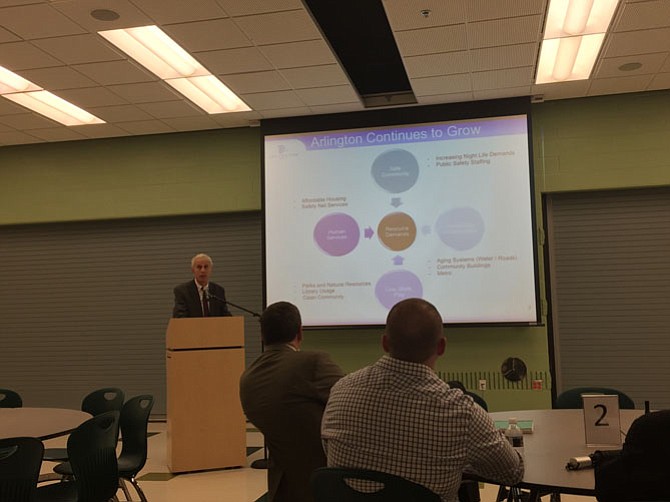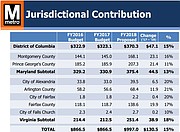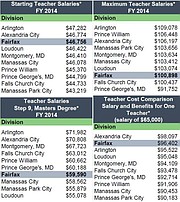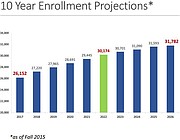County Manager Mark Schwartz presents preliminary budget information at the FY 2018 County and Schools Joint Budget Forum on Nov. 30 at Wakefield High School. Photo by Vernon Miles.
Arlington Schools are overcrowded, Metro is crumbling, and with a tight budget season Arlington County will have difficulties in saving them both. As 2016 draws to a close, Arlington County officials are starting to craft the framework for the FY2018 budget, and early indicators are showing budget gaps for services that rely heavily on Arlington County subsidies.
“As you increase fares, reduce service, and that service isn’t as reliable, fewer people are going to ride. I hope it doesn’t end up as a death spiral. It’s a very difficult situation.” — County Manager Mark Schwartz.
For Arlington County, the single largest increase in funding expenditures will be the Metro. According to County Manager Mark Schwartz, 2016 had not been a good year for the Washington Area Metropolitan Transit Authority (WMATA) and the next few years are looking even worse. Schwartz noted that the Metro has faced continually declining ridership and lower fare revenues, all while seeing contractual increases in wages and benefits. The result is a $290 million operating budget gap.
Jason Friess with Arlington’s Department of Management and Finance said there are two ways WMATA can close this gap and it will need to explore both of them: increasing revenue and increasing local subsidies.
The Metro’s FY2018 Proposed Operating Budget includes extensive service cuts and fare increases. All bus and off-peak rail prices will increase to at least $2. All peak rail fares will increase by 10 cents, with maximum fares going up from $5.90 to $6. Metro is pairing this with a service reduction, “right sizing” service to match lower ridership numbers. Average ridership has gone down to 660,000 in FY2016 from the 750,000 peak in FY2009, but the opening of the Silver Line has resulted in higher levels of rail service. Metro is estimating a savings of $12 million in reduced services, with $20 million in in reduced expenses offset by $8 million in lower fares from reduced ridership.
But Schwartz expressed misgivings about Metro’s cost savings plans.
“As you increase fares, reduce service, and that service isn’t as reliable, fewer people are going to ride,” said Schwartz. “I hope it doesn’t end up as a death spiral. It’s a very difficult situation.”
But even with fare increases and service adjustments, Schwartz said the county is still anticipating a $6 to $9 million estimated increase in Metro subsidies for Arlington.
Friess said the larger concern was the continuing costs beyond FY2018 in the operating budget and looming capital investment needs. Metro’s proposed FY2018 budget includes a three-year operating costs projection, which shows revenue slowly increasing by around $20 million each year, but with Metro expenses increasing by $100 million every year, requiring larger and larger subsidies to the Metro system.
“[Metro] is facing just as of big issues on the capital funding side,” said Friess. “They’re facing a lot of critical capital repairs and need funding above regional committed funding… In terms of budget, haven’t fully had a chance to digest it and make a decision on which way we’re going to fund it.”
Friess said much of how Arlington funds WMATA’s needs is still to be determined.
METRO IS NOT THE ONLY rising cost for the county. Arlington Public Schools (APS) funding comes from a shared local tax revenue agreement, where APS automatically receives 46.6 percent of the local tax revenue. For FY2018, that is $474.8 million, an increase over $464.5 million in FY2017. Arlington County also provides APS with $7 to $8 million in support through school resource officers, nurses, and other services. But APS still faces a $22.6 to $28.6 million budget shortfall.
According to APS Superintendent Dr. Patrick Murphy, the $10.2 million increased county transfer is not enough to cover the continued cost of enrollment growth and other expenditure increases.
The largest new expenditure in the APS budget is $11.9 million for enrollment growth. Over the last eight years, APS enrollment has increased by 6,500 students (35 percent of the school population). Over the next five years, enrollment is projected to increase by another 4,155 students. By 2022, APS will pass the 30,000 student mark.
APS has budgeted $8 million for an annual step increase for school employees and $5.5 to $9.5 million for Virginia Retirement System (VRS) and health insurance increases. Leslie Peterson, assistant superintendent of finance and management, said step increases were annual until 2010, when it was cut back to every other year during tight budget seasons. APS personnel received step increases in both FY2016 and FY2017. Peterson said the salary scales were built around step increases occurring every year.
“Teachers work hard and believe they should be compensated,” said Peterson, noting that teachers often do additional work outside of the regular classroom hours.
APS’ FY2018 expenditures also includes $6.1 million in continued implementation of growth initiatives. Peterson said this funding is for the second year of implementation for various programs initiated in FY2017 like Arlington Tech, a program started at the career center for 800 students.
“It’s an initiative for students who thrive with hands-on learning,” said Peterson. “It gives them an alternative structure and a career education.”
Arlington Tech was budgeted for $750,000 in the FY2017 budget with 4.3 full time employees. For FY2018, the budget is projected to increase to $1.17 million with 10 full time employees.
The Arlington County School Board approved a “direction for action” at its Dec. 1 meeting. Community meetings will continue throughout December. The first Community Budget Forum will be held on Dec. 13 at 7 p.m. in the Education Center, room 101. A Spanish Community Budget Forum will be held Dec. 20 at 7 p.m. at the Jefferson Middle School Library. The superintendent’s budget presentation will be on Feb. 23. The county manager’s proposed budget will be presented on Feb. 25 with public budget and tax hearings throughout March and budget adoption in April.





